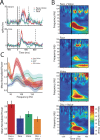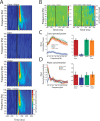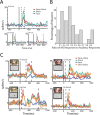Interactions between the superior temporal sulcus and auditory cortex mediate dynamic face/voice integration in rhesus monkeys
- PMID: 18434524
- PMCID: PMC2663804
- DOI: 10.1523/JNEUROSCI.0541-08.2008
Interactions between the superior temporal sulcus and auditory cortex mediate dynamic face/voice integration in rhesus monkeys
Abstract
The existence of multiple nodes in the cortical network that integrate faces and voices suggests that they may be interacting and influencing each other during communication. To test the hypothesis that multisensory responses in auditory cortex are influenced by visual inputs from the superior temporal sulcus (STS), an association area, we recorded local field potentials and single neurons from both structures concurrently in monkeys. The functional interactions between the auditory cortex and the STS, as measured by spectral analyses, increased in strength during presentations of dynamic faces and voices relative to either communication signal alone. These interactions were not solely modulations of response strength, because the phase relationships were significantly less variable in the multisensory condition as well. A similar analysis of functional interactions within the auditory cortex revealed no similar interactions as a function of stimulus condition, nor did a control condition in which the dynamic face was replaced with a dynamic disk mimicking mouth movements. Single neuron data revealed that these intercortical interactions were reflected in the spiking output of auditory cortex and that such spiking output was coordinated with oscillations in the STS. The vast majority of single neurons that were responsive to voices showed integrative responses when faces, but not control stimuli, were presented in conjunction. Our data suggest that the integration of faces and voices is mediated at least in part by neuronal cooperation between auditory cortex and the STS and that interactions between these structures are a fast and efficient way of dealing with the multisensory communication signals.
Figures







Similar articles
-
Different neural frequency bands integrate faces and voices differently in the superior temporal sulcus.J Neurophysiol. 2009 Feb;101(2):773-88. doi: 10.1152/jn.90843.2008. Epub 2008 Nov 26. J Neurophysiol. 2009. PMID: 19036867 Free PMC article.
-
Multisensory integration of dynamic faces and voices in rhesus monkey auditory cortex.J Neurosci. 2005 May 18;25(20):5004-12. doi: 10.1523/JNEUROSCI.0799-05.2005. J Neurosci. 2005. PMID: 15901781 Free PMC article.
-
Mouth and Voice: A Relationship between Visual and Auditory Preference in the Human Superior Temporal Sulcus.J Neurosci. 2017 Mar 8;37(10):2697-2708. doi: 10.1523/JNEUROSCI.2914-16.2017. Epub 2017 Feb 8. J Neurosci. 2017. PMID: 28179553 Free PMC article.
-
Stimulus-dependent activations and attention-related modulations in the auditory cortex: a meta-analysis of fMRI studies.Hear Res. 2014 Jan;307:29-41. doi: 10.1016/j.heares.2013.08.001. Epub 2013 Aug 11. Hear Res. 2014. PMID: 23938208 Review.
-
How do auditory cortex neurons represent communication sounds?Hear Res. 2013 Nov;305:102-12. doi: 10.1016/j.heares.2013.03.011. Epub 2013 Apr 17. Hear Res. 2013. PMID: 23603138 Review.
Cited by
-
Functional Organization of Social Perception and Cognition in the Superior Temporal Sulcus.Cereb Cortex. 2015 Nov;25(11):4596-609. doi: 10.1093/cercor/bhv111. Epub 2015 Jun 5. Cereb Cortex. 2015. PMID: 26048954 Free PMC article.
-
Modulation of visual responses in the superior temporal sulcus by audio-visual congruency.Front Integr Neurosci. 2010 Apr 13;4:10. doi: 10.3389/fnint.2010.00010. eCollection 2010. Front Integr Neurosci. 2010. PMID: 20428507 Free PMC article.
-
Transitions in neural oscillations reflect prediction errors generated in audiovisual speech.Nat Neurosci. 2011 Jun;14(6):797-801. doi: 10.1038/nn.2810. Epub 2011 May 8. Nat Neurosci. 2011. PMID: 21552273
-
Seeing is believing: neural representations of visual stimuli in human auditory cortex correlate with illusory auditory perceptions.PLoS One. 2013 Sep 4;8(9):e73148. doi: 10.1371/journal.pone.0073148. eCollection 2013. PLoS One. 2013. PMID: 24023823 Free PMC article.
-
Audiovisual spoken word training can promote or impede auditory-only perceptual learning: prelingually deafened adults with late-acquired cochlear implants versus normal hearing adults.Front Psychol. 2014 Aug 26;5:934. doi: 10.3389/fpsyg.2014.00934. eCollection 2014. Front Psychol. 2014. PMID: 25206344 Free PMC article.
References
-
- Barraclough NE, Xiao DK, Baker CI, Oram MW, Perrett DI. Integration of visual and auditory information by superior temporal sulcus neurons responsive to the sight of actions. J Cogn Neurosci. 2005;17:377–391. - PubMed
-
- Bernstein LE, Auer ET, Takayanagi S. Auditory speech detection in noise enhanced by lipreading. Speech Commun. 2004;44:5–18.
Publication types
MeSH terms
Grants and funding
LinkOut - more resources
Full Text Sources
